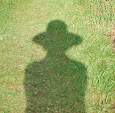We live adjacent to the earthen Roman wall, called the Antonine Wall, that was built in 140-142 AD across Scotland from the Clyde in the west to the Forth in the east (i.e. the narrowest bit of Scotland). The Roman Emperor Antonius Pius had to built to rival his predecessor, Hadrian.

Today 6 of us - CVD Dramblers - walked the middle section of it going from Auchinstarry to Barhill Fort, Croy and around to Auchinstarry to finish.
 Nowadays there is very little evidence of the actual wall but this photo shows the ditch that remains. Apparently if you fly over the area the actual line of the wall is easy to identify.
Nowadays there is very little evidence of the actual wall but this photo shows the ditch that remains. Apparently if you fly over the area the actual line of the wall is easy to identify.
 Nowadays there is very little evidence of the actual wall but this photo shows the ditch that remains. Apparently if you fly over the area the actual line of the wall is easy to identify.
Nowadays there is very little evidence of the actual wall but this photo shows the ditch that remains. Apparently if you fly over the area the actual line of the wall is easy to identify. Remains of a Roman camp with its bath houses, drains and walls are evident here at Barhill.
Remains of a Roman camp with its bath houses, drains and walls are evident here at Barhill.I particularly enjoyed looking at the area as it reminded me of the time I was chatted up ... some years ago!... in a most intriguing way.
I have to admit that over the years I have had many a one-line opener from men, like ... "Where are YOU from?" (when they hear my accent) to "Would you like to see my etchings fertility goddesses (aka wooden railway molds)?"... but I had never heard "You must see the Roman inscriptions from the Antonine Wall"... in particular, the inscriptions which indicated the distance completed by a legion after their part of the wall was built. There were quite a few along the wall but were removed and put into the Hunterian Museum at Glasgow University.
Anyhow what was of real interest was something which can be seen in this illustration:
 The letters are:
The letters are:
IMP CAES T AELIO HADR ANTONINO AVG PIO P P VEXILLA LEG VI VIC P F PER M P III DCLXVI S Translates as " " For the Emperor Caesar Titus Aelius Hadrianus Antoninus Augustus Pius, Father of this country, the Sixth Victorius, Loyal and Faithful Legion (completed the wall) over a distance of 3666 1/2 paces".
My Charming Gentleman drew my attention to the last letter of the inscription: the small 's'. It means "half". So the distance measured "3666 1/2 paces".
Question:
[1] What, exactly, is half a pace? Why make such a detailed measurement, why not either one pace or no pace? If half a pace is so important, is a full pace what we think of it being today, i.e. a stride or step when walking and counting out the number taken to give you the total distance.
Anyhow what was of real interest was something which can be seen in this illustration:
 The letters are:
The letters are:IMP CAES T AELIO HADR ANTONINO AVG PIO P P VEXILLA LEG VI VIC P F PER M P III DCLXVI S Translates as " " For the Emperor Caesar Titus Aelius Hadrianus Antoninus Augustus Pius, Father of this country, the Sixth Victorius, Loyal and Faithful Legion (completed the wall) over a distance of 3666 1/2 paces".
My Charming Gentleman drew my attention to the last letter of the inscription: the small 's'. It means "half". So the distance measured "3666 1/2 paces".
Question:
[1] What, exactly, is half a pace? Why make such a detailed measurement, why not either one pace or no pace? If half a pace is so important, is a full pace what we think of it being today, i.e. a stride or step when walking and counting out the number taken to give you the total distance.
[2] The small 's' is half. Did they have the notion of a quarter? A tenth? If so, how was it written?

To my knowledge, these questions have never been answered.
___________________________________________________________
Source:
[1] http://www.ourpasthistory.com/Scotland/antonine-wall-legionary-distance-slabs.
[2] Glasgow University's Hunterian Museum website:
http://www.hunterian.gla.ac.uk/education/romans/distance_slab.shtml




No comments:
Post a Comment